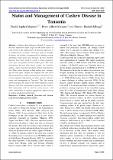| dc.description.abstract | Cashew (Anacardium occidentale L.)is one of the most important export cropsand the main source of cash income in the southern part of Tanzania. However it is challenged by a number of factors such as drought, declining soil fertility, un-improved low yielding cashew genotypes, insect pests and diseases. Of these factors, diseases have been cited to result in high production costs, poor nut quality and low market price. The most devastating diseases that attack cashew are powdery mildew, cashew leaf and nut blight, dieback and fusarium wilt.Other minor diseasesinclude anthracnose, damping off and leaf spots.Despite the negative role that these diseases possess to cashew growers, there is limited or no critical updated information on their current infection status and management in Tanzania. Thus, this review articlediscusses the status of the most important cashew diseases and their management options in the country. Such informationwill be vital to cashewfarmers and other stakeholdersin making appropriate improvements in cashew production in Tanzania. | en_US |

